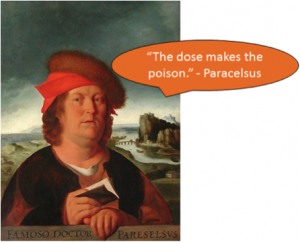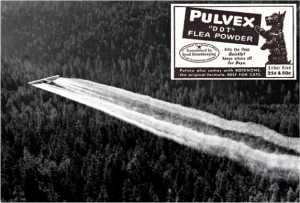By Eva Vitucci
Over 500 years ago, a man named Paracelsus stirred up the world of medicine. At that time the main belief was when an individual became sick it was because fluids in their body, such as their blood or bile, became imbalanced. Paracelsus was one of the first people to propose and support with experiments that external factors, such as things from the environment, can both make humans sick and also cure them of their illnesses. This belief led to one of his most famous quotes: “All things are poison and nothing is without poison; only the dose makes a thing not a poison,” and led to the beginning of the field of toxicology.
Modern toxicology is now described as the field of science dedicated to studying the effects of substances, such as poisons and chemicals, on people, animals, and the environment. The overall significance of a toxicologist’s job is to identify and remove potentially harmful substances in every part of our lives (the air we breathe, our drinking water, plastic water bottles, new energy drinks, etc.). Once toxicologists identify that something is bad for us, they then inform the government and work together to remove the substance from our stores and products. For example, the insect killing chemical, DDT (dichloro-diphenyl-trichloloethane) was created around 1940 to help kill mosquitos and other insects that carried diseases such as malaria. It was a fantastic insect killer and is thought to have prevented hundreds of people from dying of malaria. Unfortunately, scientists started noticing bird and fish populations decreasing in the same areas where DDT was used. Toxicologists were then called in to examine DDT’s effect on other animals and humans. They determined that DDT didn’t just kill mosquitos, but that it negatively affected many different kinds of animals. The discoveries made by these toxicologists led to the removal of DDT from usage in the United States in 1972 and has increased scientists’ awareness of the effects other insecticides can have on our environment.
Interestingly, not all toxins are bad for humans and our environment. Paracelsus pointed out in his famous quote that only the dose of a substance makes it toxic. In other words, something seemingly safe can become toxic when an individual is exposed to too high amounts (i.e. drinking excessive amounts of water) and something seemingly dangerous can actually be used safely if the amount is monitored (i.e. radiation used to treat cancer). To date, there are thousands of research studies in which toxicologists and other scientists show that plant toxins and animal venoms can be used as chemotherapeutic agents to treat cancer. For example, a snake venom known as Lebein prevents blood vessels in our body from growing and thus cuts off the flow of oxygen and nutrients between our organ systems. However, scientists and toxicologists have identified a safe amount of Lebein that can be used to cut-off the supply of blood vessels to tumors but not to our other organs. Thus, when used in the right amount, this seemingly dangerous toxin can actually be beneficial to human health by treating cancer!
Ultimately, the substances of study for toxicologists can range from man-made chemicals to natural plant products. The job of a toxicologist can focus on identifying what substance is causing harm to humans and our environment or on identifying new substances to cure human diseases (this is how the common bacteria-killing drug, penicillin, was identified in mold). In a way, toxicologists are like scientific detectives, always looking for the culprit or the new cure. If you love solving mysteries and asking questions, maybe you could be the next Sherlock Holmes of toxicology!
Edited by Yitong Li and Allyson Roberts


